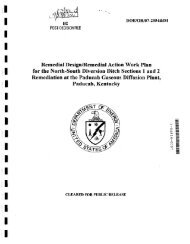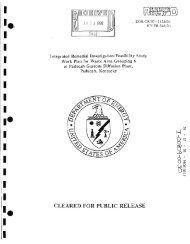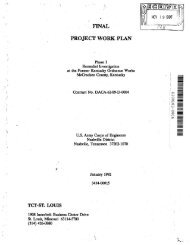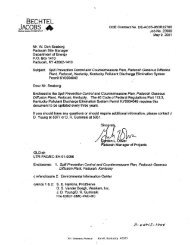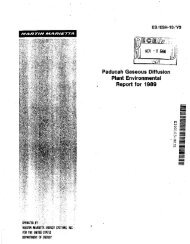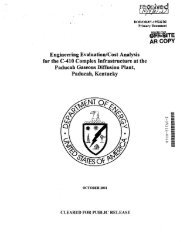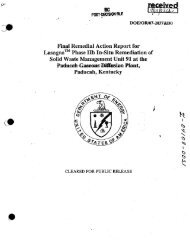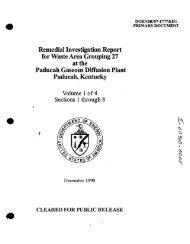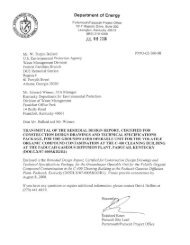1 - paducah environmental information center
1 - paducah environmental information center
1 - paducah environmental information center
You also want an ePaper? Increase the reach of your titles
YUMPU automatically turns print PDFs into web optimized ePapers that Google loves.
Annual Site Environmental Report for 1999<br />
machines that grasp and lift the cylinder with<br />
hydraulically controlled tines.<br />
The "mission" of the DUF 6 Cylinder<br />
Program is to safely store the DOE-owned DUF6<br />
inventory until its ultimate disposition. The<br />
DUF 6 Cylinder Program Management Plan was<br />
established to meet the program mission. The<br />
plan ,has components (such as DUF 6 , cylinders,<br />
cylinder yards, cylinder-handling equipment,<br />
personnel, and financial resources) and activities<br />
(such as operations, management processes, and<br />
administration).<br />
The congressional adjustment of DOE's<br />
mission from uranium enrichment to , uranium<br />
inventory management (storage and utilization)<br />
has transformed the previous management plan<br />
from design, construction, and, operation phases<br />
to a storage or standby phase. The Program<br />
Management Plan for which DOE is responsible<br />
has been realigned to containment and use of a<br />
finite inventory of DUF 6 . The various types of<br />
construction and the subsequent deterioration of<br />
the yards have led to substandard storage<br />
conditions for many of the cylinders. The<br />
variety of cylinder deSigns that have evolved<br />
over the years and various, paint systems used<br />
have resulted in varying corrosion rates. These<br />
two main factors led to the need for long-term<br />
corrosion monitoring of the cylinders.<br />
Potential risks to people and the environment<br />
posed by DUF 6 storage as it is ~anaged are low.<br />
The DUF 6 is stored as a crystalline solid at less<br />
than atmospheric pressure. When DUF 6 is<br />
exposed to the atmosphere, hydrogen fluoride<br />
and, uranium reaction products form. The<br />
uranium by~products' form a hard crystalline<br />
solid, whichi acts as a self~sealant within the<br />
storage cylinder. The hazard potential ·of the<br />
DliF6 .is primarily cheniical toxicity from any<br />
released hydrogen fluoride, rather than, a<br />
radiol~gical hazard.<br />
, Mter;., visiting, the Paducah; Portsmouth,<br />
and K -25. [currently identified' as East Te~nessee<br />
Technology Park (ETTP)] sites in '1994 and<br />
1995, the Defense Nuclear Facilities Safety<br />
Board (DNFSB) issued Recommendation 95-1<br />
and a supporting technical report. That report<br />
addressed the improved safety of cylinders<br />
containing DUF 6 . Recommendation 95-1 on<br />
Depleted Uranium recommended the following:<br />
• Start an early program to renew the<br />
protective coating of cylinders containing<br />
DUF 6 from the historical production of<br />
enriched uranium.<br />
• Explore the possibility of additional<br />
measures to protect these cylinders from<br />
the damaging effects of exposure to the<br />
elements, as well as any additional<br />
handling th~t may occur.<br />
• Institute a study to determine<br />
whether a more suitable chemical forin<br />
should be selected for long-term storage<br />
of the depleted uranium.<br />
On June 29, 1995, DOE formally accepted<br />
Recommendation 95-1 and emphasized five<br />
focus areas for DOE response:<br />
• Removing cylinders from ground<br />
contact arid keeping cylinders from<br />
further ground contact;<br />
• Relocating all, cylinders into an<br />
adequate inspection configuration (this<br />
effort continued in 1999 as new storage<br />
yards were constructed or as existing<br />
yards were refurbished);<br />
• Repainting cylinders as needed to<br />
avoid excessive corrosion (cylinder<br />
painting was' suspended in 1999);<br />
• Updating handling and inspection<br />
procedures and site-specific Safety<br />
Analysis Reports; and<br />
• Completing an ongoing study that<br />
will include an analysis of alternative<br />
,;chemical forms for the material (on April<br />
15, 1999, DOE issued the Final<br />
"<br />
Environmental Program Information<br />
3-17



